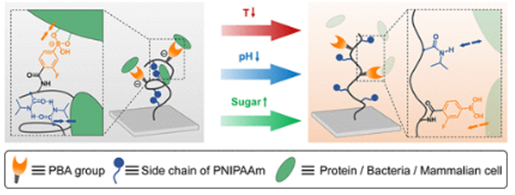Multistimulus Responsive Biointerfaces with Switchable Bioadhesion and Surface Functions
Yang Zhou1, Yanjun Zheng1, Ting Wei1, Yangcui Qu1, Yaran Wang1, Wenjun Zhan1, Yanxia Zhang2, Guoqing Pan 3, Dan Li1*(李丹), Qian Yu1*(于谦), and Hong Chen1
1 State and Local Joint Engineering Laboratory for Novel Functional Polymeric Materials, College of Chemistry, Chemical Engineering and Materials Science, Soochow University, Suzhou 215123, P. R. China
2 Institute for Cardiovascular Science and Department of Cardiovascular Surgery of the First Affiliated Hospital, Soochow University, Suzhou 215007, P. R. China
3 Institute for Advanced Materials, School of Materials Science and Engineering, Jiangsu University, Zhenjiang 212013, P. R. China
ACS Appl. Mater. Interfaces 2020, 12, 5447--5455
Stimuli-responsive biointerfaces can serve as dynamic tools for modulation of biointerfacial interactions. Considering the complexity of biological environments, surfaces with multistimulus responsive switchable bioactivity are of great interest. In the work reported herein, a multistimulus responsive biointerface with on–off switchable bioadhesion (protein adsorption, bacterial adhesion, and cell adhesion) and surface functions in response to change in temperature, pH, or sugar content is developed. This surface is based on a silicon modified with a copolymer containing a thermoresponsive component (poly(N-isopropylacrylamide)) and a component, phenylboronic acid, that can form pH-responsive and sugar-responsive dynamic boronate ester bonds with diol-containing molecules. It is shown that biointeractions including protein adsorption and release, bacteria and cell attachment and detachment on this surface can be regulated by changing temperature, pH, and sugar content of the medium, either individually or all three simultaneously. Furthermore, this surface can switch between two different functions, namely between killing and releasing bacteria, by introduction of a diol-containing biocidal compound. Compared to switchable surfaces that are responsive to only one stimulus, our multistimulus responsive surface is better adapted to respond to the multifunctional complexities of the biological environment and thus has potential for use in numerous biomedical and biotechnology applications.

链接:https://pubs.acs.org/doi/abs/10.1021/acsami.9b18505